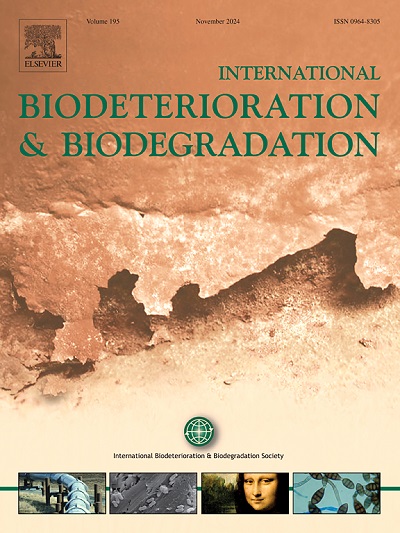Vertical distribution and environmental controls of methane cycling processes and associated microbial communities in Lake Chaohu sediments
IF 4.1
2区 环境科学与生态学
Q2 BIOTECHNOLOGY & APPLIED MICROBIOLOGY
International Biodeterioration & Biodegradation
Pub Date : 2025-05-04
DOI:10.1016/j.ibiod.2025.106105
引用次数: 0
Abstract
Methane cycling in eutrophic freshwater lake sediments plays a crucial role in global greenhouse gas emissions. However, the vertical distribution patterns of methane cycling-related microbial processes and their controlling factors remain poorly understood in these ecosystems. Here, we quantified the activity potentials of methane cycling processes in sediments through culture experiments with different treatments, integrating molecular microbiology (metagenomics and qPCR) and sediment characteristics. Results revealed that activity potentials of methane cycling-related processes decreased with sediment depth, while the abundances of genes including mcrA, pmoA, NC10 pmoA, and ANME-2d mcrA showed significantly different patterns in their vertical distribution. A shift from acetotrophic to hydrogenotrophic methanogenesis was observed with increasing depth, occurring at 15–20 cm depth. Moreover, nitrate served as the predominant environmental driver of methane cycling in Lake Chaohu sediments. Significant differences were observed in both community composition and dominant genera of methane cycling-related microorganisms between the 0–20 cm and 20–45 cm sediment layers, with the upper layer dominated by aerobic methane oxidation and the lower layer characterized by nitrate-dependent anaerobic methane oxidation and methanogenesis. This study provides the first comprehensive investigation of methane cycling activity potentials and describes the distribution and environmental controls of methane cycling-related microbes across different sediment depths in a eutrophic freshwater lake. These findings advance our understanding of methane cycling processes in eutrophic lake sediments, providing crucial data and a theoretical foundation for understanding the natural sources and sinks of greenhouse gases, as well as potential strategies for mitigating methane emissions from eutrophic lakes.

巢湖沉积物甲烷循环过程及其微生物群落的垂直分布与环境控制
富营养化淡水湖沉积物中的甲烷循环在全球温室气体排放中起着至关重要的作用。然而,这些生态系统中甲烷循环相关微生物过程的垂直分布格局及其控制因素尚不清楚。本文结合分子微生物学(宏基因组学和qPCR)和沉积物特征,通过不同处理的培养实验,量化了沉积物中甲烷循环过程的活性势。结果表明,甲烷循环相关过程的活度电位随沉积物深度的增加而降低,而mcrA、pmoA、NC10 pmoA和ANME-2d mcrA基因的丰度在垂直分布上存在显著差异。随着深度的增加,观察到从丙酮营养向氢营养甲烷生成的转变,发生在15-20 cm深度。此外,硝酸盐是巢湖沉积物甲烷循环的主要环境驱动力。0-20 cm和20-45 cm沉积物层间甲烷循环相关微生物群落组成和优势属均存在显著差异,上层以好氧甲烷氧化为主,下层以依赖硝酸盐的厌氧甲烷氧化和产甲烷为主。本研究首次全面研究了富营养化淡水湖不同沉积物深度甲烷循环相关微生物的分布和环境控制。这些发现促进了我们对富营养化湖泊沉积物中甲烷循环过程的理解,为了解温室气体的自然来源和汇以及减少富营养化湖泊甲烷排放的潜在策略提供了重要的数据和理论基础。
本文章由计算机程序翻译,如有差异,请以英文原文为准。
求助全文
约1分钟内获得全文
求助全文
来源期刊
CiteScore
9.60
自引率
10.40%
发文量
107
审稿时长
21 days
期刊介绍:
International Biodeterioration and Biodegradation publishes original research papers and reviews on the biological causes of deterioration or degradation.

 求助内容:
求助内容: 应助结果提醒方式:
应助结果提醒方式:


